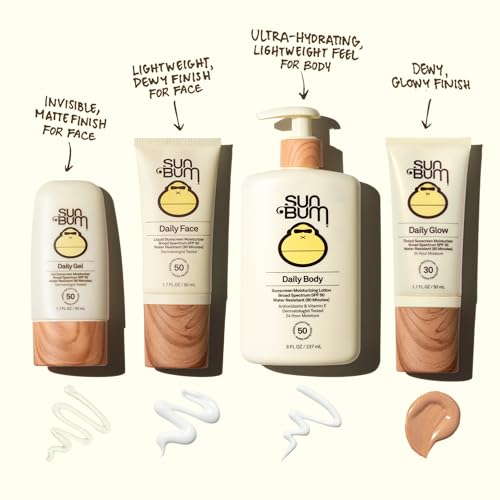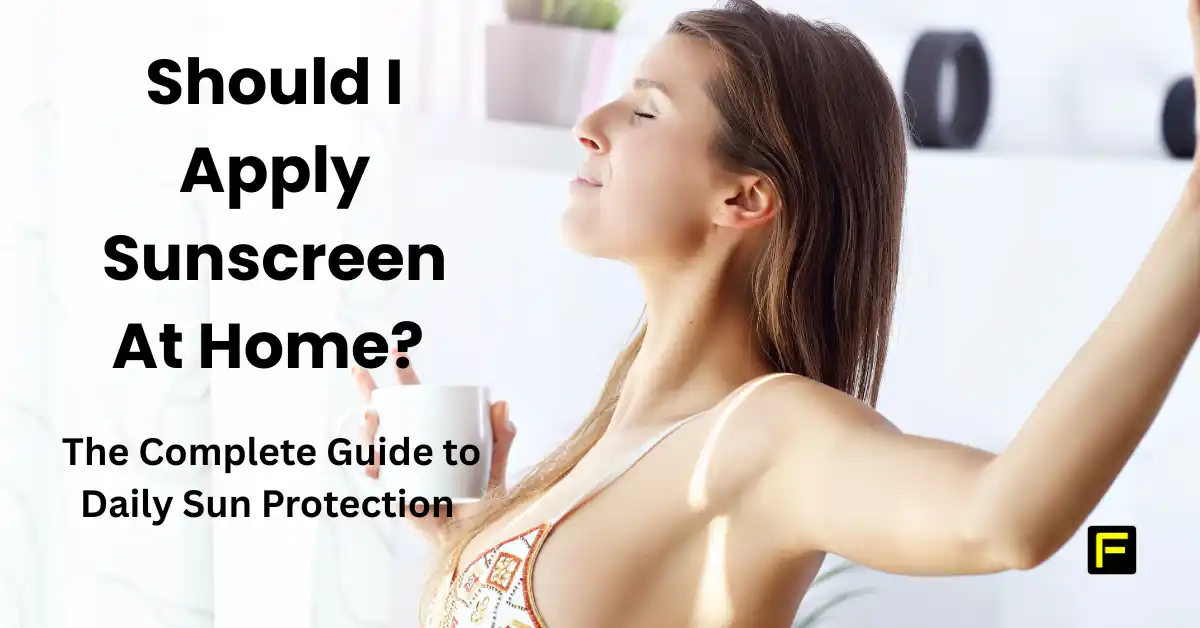If you’re like most Americans wondering, should I apply sunscreen at home, my answer is a resounding yes. This isn’t just for beach days or weekend hikes in your state park. Sun damage occurs daily, even when you’re relaxing in your living room or working from your home office in Nashville or anywhere across the US.

Table of Contents
The Hidden Danger: UV Rays Are Everywhere in American Homes
Sun damage doesn’t announce itself with a warning. Those ultraviolet (UV) rays reach your skin through windows while you’re working from home, driving on I-66, or enjoying your morning coffee by your east-facing kitchen window.
Recent research from the Skin Cancer Foundation reveals that glass blocks UVB rays but allows up to 75% of damaging UVA rays to penetrate, putting your skin at risk even when indoors. Dr. Elizabeth Hale, a board-certified dermatologist and spokesperson for the American Academy of Dermatology, explains: “Many patients are surprised to learn they need sun protection indoors, but UVA rays penetrate window glass and can cause significant damage over time.”
What dermatologists want Americans to understand is that sun damage is cumulative. Every bit of unprotected exposure adds up over time, leading to:
- Premature skin aging (wrinkles, fine lines, and sagging skin)
- Hyperpigmentation and age spots common in mature skin
- Weakened skin barrier that makes over-50 skin more vulnerable
- Increased risk of skin cancer, particularly for fair-skinned Americans
The Science Behind Sun Damage for Mature Skin

For those of us over 50, the damage caused by UV radiation is particularly concerning. UV-induced immunosuppression contributes to skin cancer by damaging DNA and inhibiting protective mechanisms within the skin. When UV rays penetrate your skin, they create free radicals that damage skin cells and can lead to the mutations that cause cancer.
Here’s a sobering statistic from the latest research published in JAMA Dermatology (2023): Americans who experienced five or more blistering sunburns between ages 15-20 have an 80% increased risk of melanoma. And according to the American Cancer Society’s 2025 data, skin cancer remains the most common cancer in the United States, with over 5 million cases diagnosed annually.
Do I Need Sunscreen Indoors in Different US Regions?

The answer varies based on your location and home environment:
- East Coast homes (like in Virginia, Maryland, New York): Large windows facing east/west require protection, especially from 10 AM to 4 PM
- Southern states (Florida, Texas, Arizona): Higher year-round UV index means daily protection is essential, even indoors
- Midwest and Northern regions: Don’t be fooled by cloudy days—UV rays penetrate cloud cover
- West Coast homes: Large picture windows common in California architecture increase indoor UV exposure
According to meteorologists at The Weather Channel, many parts of the US experience UV Index readings of 3 or higher nearly year-round, especially in southern and mountain states. When the UV Index is 3 or greater, dermatologists recommend applying sunscreen with an SPF of at least 30, even if you’ll be mostly indoors.
See my recent article on the 9 Best Products for Sun Damaged Skin on Face.
The Benefits of Applying Sunscreen at Home for Mature Skin
Wearing sunscreen inside offers multiple benefits for people over 50:
- Prevents further aging: A 2024 study in the Journal of the American Academy of Dermatology found that daily sunscreen users showed 24% less skin aging over a 4-year period compared to occasional users
- Maintains even skin tone: Reduces age spots and melasma, common concerns for mature skin
- Protects thinning skin: As we age, our skin thins naturally, making protection even more crucial
- Provides cumulative protection: Every day you protect your skin adds years of healthy appearance
Dr. Shari Marchbein, Clinical Assistant Professor of Dermatology at NYU, notes: “For my patients over 50, daily sunscreen is non-negotiable. The thinning of skin that naturally occurs with age makes proper sun protection even more crucial.”
The Right Way to Apply Sunscreen at Home for Americans Over 50
For optimal protection, follow these simple steps tailored for mature skin:
- Apply first thing in the morning: Make sunscreen the final step in your morning skincare routine, after moisturizer but before makeup
- Use the right amount for aging skin: For full-body protection, you need about one ounce—a shot glass full. For just your face, neck, and hands (the areas most exposed at home), use a quarter-sized amount
- Don’t forget often-missed areas: Ears, neck, backs of hands, and scalp (especially for those with thinning hair)
- Reapply if needed: If you’re sitting by a window all day or go outside to check the mail or water plants, reapply every two hours
Choosing the Best Sunscreen for Daily Home Use in America
For daily home use in the US market, look for these features:
- Broad-spectrum protection: Guards against both UVA and UVB rays
- SPF 30 or higher: The American Academy of Dermatology recommends using broad-spectrum sunscreen with an SPF 30 or higher daily
- Moisturizing formulas: Mature skin benefits from hydrating sunscreens with ingredients like hyaluronic acid or ceramides
- Fragrance-free options: Ideal for sensitive skin common in the over-50 demographic
Best Sunscreens Available in US Stores for the Whole Family
Based on 2025 dermatologist recommendations and Consumer Reports testing:
For Daily Face Use:
 Buy now
Buy now
- EltaMD UV Clear Broad-Spectrum SPF 46 – Excellent for sensitive and rosacea-prone mature skin
- Supergoop Unseen Sunscreen SPF 40 – Truly invisible on all skin tones with a velvet finish
- La Roche-Posay Anthelios Light Fluid SPF 60 – Lightweight with anti-aging antioxidants
For Body Protection:
 Buy now
Buy now
- Sun Bum Original SPF 50 – Pleasant scent, easy application, widely available at Target and Walmart
- Neutrogena Ultra Sheer Dry-Touch SPF 100+ – Maximum protection with a non-greasy finish
- Hawaiian Tropic Silk Hydration Weightless SPF 30 – Hydrating formula ideal for drier mature skin
For Grandchildren:
 Buy now
Buy now
- Thinkbaby Safe Sunscreen SPF 50+ – Gentle formula free from harmful chemicals
- Blue Lizard Australian Sunscreen SPF 50+ – Bottle turns blue in UV light as a reminder to apply
- Neutrogena Pure & Free Baby SPF 50 – Specially formulated for sensitive young skin
Common Sunscreen Myths Debunked for American Consumers
Let’s clear up some misconceptions about sunscreen for indoor use that I often hear from my American readers:
Myth 1: “I don’t need sunscreen on cloudy days or indoors in winter”
Truth: Even on cloudy days in Washington DC, New York, or Chicago, up to 80% of UV radiation reaches your skin. Winter sun reflecting off snow in northern states can actually increase UV exposure.
Myth 2: “Sunscreen blocks vitamin D production, which I need more of as I age”
Truth: According to a 2023 study in the Journal of Investigative Dermatology, regular sunscreen use has minimal impact on vitamin D levels. Most Americans over 50 should take vitamin D supplements regardless of sunscreen use, as recommended by the American Geriatrics Society.
Myth 3: “One morning application lasts all day at home”
Truth: No sunscreen completely blocks UV radiation. If you’re sitting near windows or stepping outside to get the mail or newspaper, reapply at least every two hours.
Myth 4: “SPF 100 provides twice the protection of SPF 50”
Truth: According to the FDA, SPF 30 blocks about 97% of UVB rays, while SPF 50 blocks about 98%. The difference between SPF 50 and SPF 100 is minimal—proper application and reapplication matter more than extremely high SPF numbers.
Applying Before Leaving Home vs. Waiting: The Crucial Difference
There’s a significant difference between applying sunscreen before sun exposure and waiting until you’re already outside:
Applying at Home (Recommended):
- Allows sunscreen to form a proper protective barrier (chemical sunscreens need 15-30 minutes to become effective)
- Ensures complete coverage without missed spots
- Protects you during your commute (car windows block UVB but not UVA)
- The Skin Cancer Foundation recommends applying sunscreen to your entire body before dressing to ensure protection if clothing shifts
Waiting to Apply (Not Recommended):
- Exposes skin to damaging UV rays during travel time to the beach or park
- Often results in rushed application and missed areas
- May not allow sufficient absorption time before intense sun exposure
- Increases risk of sunburn on commonly forgotten areas like ears and neck
After-Sun Care: An Essential Step for Mature Skin
Even with diligent sunscreen use, your skin needs care after sun exposure. After-sun treatments are particularly important for mature skin to:
- Replenish lost moisture in naturally drier over-50 skin
- Calm inflammation and redness
- Support skin repair processes that slow with age
- Provide antioxidants to counteract free radical damage
For effective after-sun care at any age:
- Hydrate from within: Drink plenty of water to rehydrate your body, especially important for older adults who may have a diminished thirst response
- Cool and soothe: Apply products with anti-inflammatory ingredients like aloe vera, cucumber, or green tea
- Restore moisture: Use products with hyaluronic acid, glycerin, and ceramides to address the moisture loss common in mature skin
- Replenish antioxidants: According to a 2024 study in the Journal of Cosmetic Dermatology, applying antioxidants after sun exposure helps mitigate damage from UV-induced free radicals
Great after-sun products widely available in US stores include:
- Aloe vera gel (pure and refrigerated for extra cooling)
- CeraVe Moisturizing Cream (helps restore the skin barrier with ceramides)
- Neutrogena Hydro Boost Gel Cream (with hyaluronic acid for intense hydration)
Making Sun Protection a Family Tradition Across Generations
As the over-50 generation, we have the wisdom to teach younger family members about sun protection. Make it a family value by:
- Creating a “sunscreen station” by your front door with options for all family members
- Gifting quality sunscreens to adult children and grandchildren
- Sharing your personal experiences with sun damage to motivate younger generations
- Modeling good habits by applying your own sunscreen daily before family gatherings
Take Action Now: Your Skin Deserves Daily Protection
So, should I apply sunscreen at home? Absolutely. Daily sunscreen isn’t just a beauty tip—it’s essential preventive healthcare for Americans over 50.
Here’s your action plan starting today:
- Place your sunscreen next to your toothbrush as a visual reminder for your morning routine
- Set a calendar reminder on your phone to purchase a new bottle every 3 months (sunscreen expires!)
- Download a UV Index app specific to your location in Ashburn, Virginia or wherever you live in the US
- Schedule an annual skin check with a board-certified dermatologist near you
Remember, it’s never too late to start protecting your skin. Even if you’ve had sun damage in the past, beginning proper sun protection today can prevent further damage and may even allow your skin to repair some existing damage.
Your future self will thank you for making sunscreen a non-negotiable part of your daily routine, whether you’re heading to the National Mall in DC or just enjoying your morning coffee at home.
For more skin protection tips tailored to Americans over 50, visit FitFab50.com or consult with a board-certified dermatologist in your area.

Claudia Faucher is a full-time fitness training expert and lifestyle blogger. She is also been a certified Les Mills BodyPump instructor for the past 5 years and a fitness instructor for over 20 years. Claudia is a personal trainer and creates fitness training programs for seniors and people of all ages. She likes to use her skills and experiences to help others on their fitness journeys.
Last update on 2025-12-18 / Affiliate links / Images from Amazon Product Advertising API
